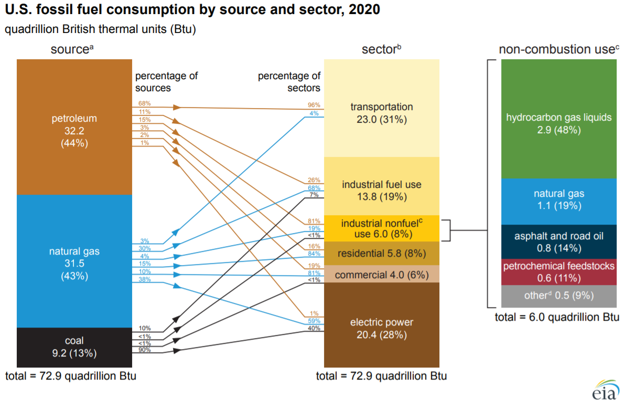

In 2020, total consumption of fossil fuels in the United States, including petroleum, natural gas, and coal, fell to 72.9 quadrillion British thermal units (Btu), down 9% from 2019 and the lowest level since 1991, according to our Monthly Energy Review. Our new chart of U.S. fossil fuel consumption by source and sector shows how each sector consumes fossil fuels. The chart also shows fossil fuels used for industrial non-combustion or nonfuel purposes, for example, in making plastics and chemicals.
Last year marked the largest annual decrease in U.S. fossil fuel consumption in both absolute and percentage terms since at least 1949, the earliest year in our annual data series. Economic responses to the COVID-19 pandemic in 2020, including a 15% decrease in energy consumption in the U.S. transportation sector, drove much of the decline. The United States also had relatively warmer weather in 2020, which reduced demand for heating fuels.

Source: U.S. Energy Information Administration, Monthly Energy Review Note: Click for full U.S. fossil fuel chart and for footnotes.
We convert sources of energy to common units of heat, called British thermal units (Btu), to compare different types of energy that are usually measured in units that are not directly comparable.

Source: U.S. Energy Information Administration, Monthly Energy Review
Petroleum products, including motor gasoline, distillate fuel oil (diesel), and hydrocarbon gas liquids (HGLs), accounted for 44% of U.S. fossil fuel consumption in 2020. Every sector consumes petroleum, but the transportation sector accounted for about 68% of total petroleum consumption in 2020. Overall, U.S. petroleum consumption fell 13% in 2020 from 2019.
Natural gas accounted for 43% of U.S. fossil fuel consumption in 2020, the largest annual share on record. Every sector consumes natural gas, but the electric power sector accounted for a record-high 38% of total natural gas consumption to generate electricity and heat in 2020. Over 80% of the fossil fuel energy directly consumed in the residential and commercial sectors is natural gas, and it is mostly used for space heating. Overall, U.S. natural gas consumption decreased 2% in 2020 from 2019.
Coal accounted for 13% of U.S. fossil fuel consumption in 2020, the lowest annual share since 1949. Overall, U.S. coal consumption fell 19% in 2020 from 2019, the largest annual decrease on record. The electric power sector consumed about 90% of total coal consumption to generate electricity and heat in 2020. Coal used for electricity generation has steadily declined over the past decade, although we expect it to increase this year, according to the June update of our Short-Term Energy Outlook.
Nonfuel use of fossil fuels accounted for about 8% of U.S. fossil fuel consumption in 2020. Fossil fuels can be consumed—and not combusted, or burned—when they are used directly as construction materials, chemical feedstocks, lubricants, solvents, and waxes. HGLs accounted for 48% of U.S. nonfuel use of fossil fuels in 2020.

Source: U.S. Energy Information Administration, Monthly Energy Review
Source: EIA